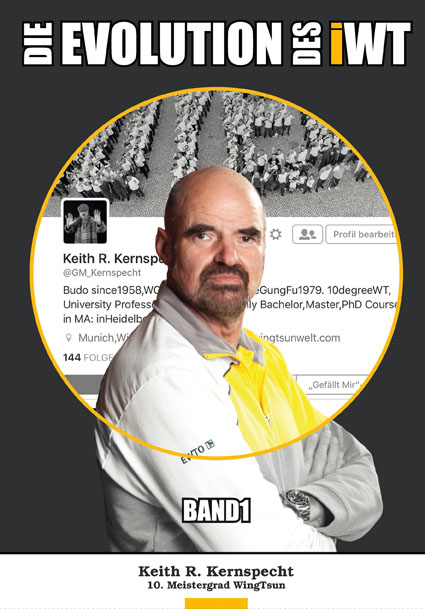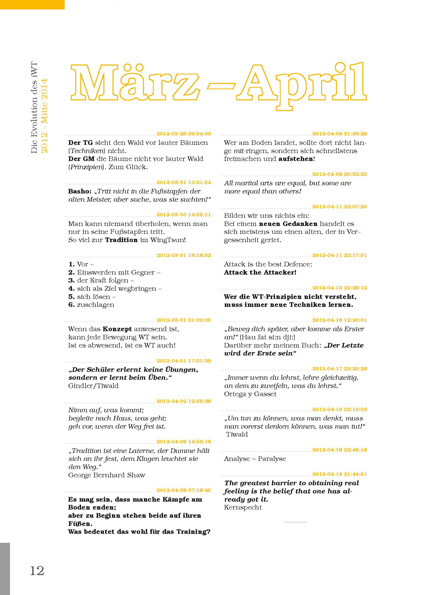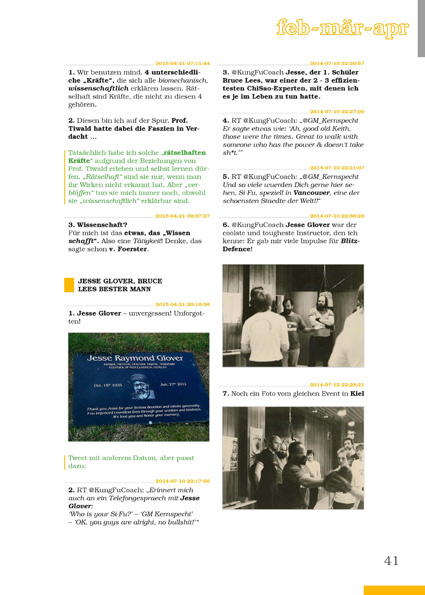The evolution of iWT
This latest book written by GM Kernspecht and published by EWTO-Verlag enables all loyal followers, and especially also those who have not been following the development of inner WingTsun on Twitter, to read about the process in chronological order from its beginnings to mid-2014. A continuation with the Tweets from July 2014 onwards will follow. Incidentally, those who want to stay up-to-date and follow the evolution of iWT as it happens are well-advised to register as a follower of @GM_Kernspecht.
Here is the foreword to the first volume as a foretaste:
Return journey from tradition to modernity and back
 Combining ancient with new knowledge has always been one of the key principles by which Grandmaster Kernspecht has been researching into the art of fighting for over half a century – and especially into WingTsun.
Combining ancient with new knowledge has always been one of the key principles by which Grandmaster Kernspecht has been researching into the art of fighting for over half a century – and especially into WingTsun.
This principle takes on a solid form with this first volume in a planned series. Grandmaster Kernspecht has collated his publications in one of the very latest media – his "Tweets" on "Twitter" – in one of the most traditional media of all, namely a book.
As in the martial arts, this is not a matter of art for art's sake. His aim is instead to combine the best of different worlds: the immediacy of Twitter with the compactness of a book, daily updates with historical reviews and online speed with offline perpetuity.
Since it began to be spread in the western countries in the mid-1970s, WingTsun has been classified as one of the "inner" KungFu styles. Little attention has however been given to the origins of the style's content beyond the teachings of the WingTsun grandmaster Yip Man. After all, the latter imparted an ingenious martial arts system to his last student, Leung Ting, and he in turn made it teachable to large groups with sophisticated training programmes.
Once Sifu Kernspecht had learned the entire system from his teacher, and himself been appointed a grandmaster in 2000, he followed his teacher's lead and set about detailed research into the roots of WingTsun.
 During the course of this research his gaze extended well beyond the garden fence of his own style. He not only included other KungFu styles in his investigations, but also the martial arts of more recent and ancient eras, and different cultural groups. He took into account the findings of movement researchers such as Moshé Feldenkrais, Ida Rolf, Heinrich Jacoby, Elsa Gindler, Charlotte Selver, Thomas Hanna and Salomon Stricker, and also research findings from the modern sports and movement sciences. Psychological and philosophical aspects (e.g. Gottlob Frege, Viktor von Weizsäcker) were another important part of this work.
During the course of this research his gaze extended well beyond the garden fence of his own style. He not only included other KungFu styles in his investigations, but also the martial arts of more recent and ancient eras, and different cultural groups. He took into account the findings of movement researchers such as Moshé Feldenkrais, Ida Rolf, Heinrich Jacoby, Elsa Gindler, Charlotte Selver, Thomas Hanna and Salomon Stricker, and also research findings from the modern sports and movement sciences. Psychological and philosophical aspects (e.g. Gottlob Frege, Viktor von Weizsäcker) were another important part of this work.
Via his doctorate and professorship at the University of Plovdiv in Bulgaria, Prof. Dr. Kernspecht came into contact with Prof. Dr. Horst Tiwald, professor of sport sciences at the University of Hamburg from 1973 until his retirement in 2003. As part of his specialist field of "transcultural movement research", Prof. Tiwald focused his attention very strongly on cultural dialogue with China. He had a particular interest in the martial arts and Chan-Buddhism.
During his intensive exchange of correspondence with Prof. Tiwald, Prof. Kernspecht devoted his research work to the traditional "inner" martial arts styles – among them Pakua, Hsing-I and TaiChi – and began to study them in great depth.
Gradually he began to discover the original philosophical ideas and movement concepts from which "modern" WingTsun was developed. These newly gained findings enabled him to put the movement principles, learning/training methods and fighting strategies of WingTsun in a wider overall context, and explain this to his students. "Inner WingTsun" – iWT for short – was born.
 Right from the start, Grandmaster Keith R. Kernspecht kept his students abreast of the latest research results on Inner WingTsun on Twitter @GM_Kernspecht. He made use of the restriction to a certain number of characters per Tweet to formulate his ideas precisely, and used the "social" characteristics of this medium to exchange views with the students practically immediately. The latter attribute is an advantage of Twitter that should not be underestimated.
Right from the start, Grandmaster Keith R. Kernspecht kept his students abreast of the latest research results on Inner WingTsun on Twitter @GM_Kernspecht. He made use of the restriction to a certain number of characters per Tweet to formulate his ideas precisely, and used the "social" characteristics of this medium to exchange views with the students practically immediately. The latter attribute is an advantage of Twitter that should not be underestimated.
Because when studying Inner WingTsun, understanding the all-embracing theory is just as important as direct, practical instruction by an experienced teacher who can give the student the right "touch". Anybody who has started to embark on this course of study knows only too well how many questions can arise.
The first volume of the series "The Evolution of iWT" on the development of Inner WingTsun contains a selection of the most important Tweets from 2012 to mid-2014. The subsequent comments on the state of research at the time, added by Grandmaster Kernspecht from today's perspective and highlighted in green, are particularly interesting from a historical point of view, as well as to the active iWT student.
Markus Senft
Details of the first volume in the series "The Evolution of iWT", published as a limited edition:
116 pages, A4 format,
EWTO-Verlag, 1st German edition May 2016
Price: Softcover € 19,–; Hardcover € 28,–
The book can be mail-ordered from the EWTO now. Deliveries will commence after the International Anniversary Seminar, where the book can also be purchased directly.


